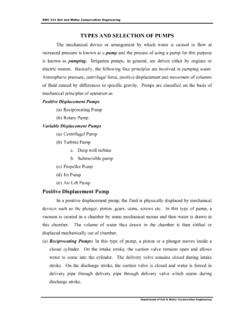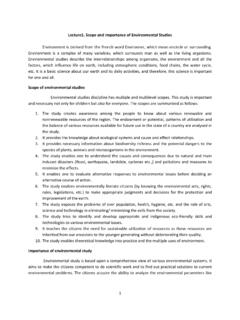Transcription of 1. Agriculture Heritage in India - eagri.org
1 1. Agriculture Heritage in India Globally Important Agricultural Heritage Systems (GIAHS), as defined by the FAO (Food and Agriculture Organization of the UNO), are: "Remarkable land use systems and landscapes which are rich in globally significant biological diversity evolving from the co-adaptation of a community with its environment and its needs and aspirations for sustainable development".[1]. Worldwide, specific agricultural systems and landscapes have been created, shaped and maintained by generations of farmers and herders based on diverse natural resources, using locally adapted management practices. Building on local knowledge and experience, these ingenious agri-cultural systems reflect the evolution of humankind, the diversity of its knowledge, and its profound relationship with nature.
2 These systems have resulted not only in outstanding landscapes, maintenance and adaptation of globally significant agricultural biodiversity, indigenous knowledge systems and resilient ecosystems, but, above all, in the sustained provision of multiple goods and services, food and livelihood security for millions of local community members and indigenous peoples, well beyond their borders. For millennia communities of farmers, herders, fishers and forest people have developed complex, diverse, and locally adapted agricultural systems. These systems have been managed with time-tested, ingenious combinations of techniques and practices that have usually led to community food security, and the conservation of natural resources and biodiversity.
3 Agricultural Heritage systems can still be found throughout the world covering about 5 million hectares, which provide a vital combination of social, cultural, ecological and economical services to humankind. These Globally Important Agricultural Heritage Systems-GIAHS have resulted not only in outstanding landscapes of aesthetic beauty, maintenance of globally significant agricultural biodiversity, resilient ecosystems and a valuable cultural Heritage Above all these systems sustainabley provide multiple goods and services, food and livelihood security for millions of poor and small farmers. The existence of numerous GIAHS around the world testifies to the inventiveness and ingenuity of people in their use and management of the finite resources, biodiversity and ecosystem dynamics, and ingenious use of physical attributes of the landscape, codified in traditional but evolving knowledge, practices and technologies.
4 Whether recognized or not by the scientific community, these ancestral agricultural systems constitute the foundation for contemporary and future agricultural innovations and technologies. Their cultural, ecological and agricultural diversity is still evident in many parts of the world, maintained as unique systems of Agriculture . Through a remarkable process of co-evolution of Humankind and Nature, GIAHS have emerged over centuries of cultural and biological interactions and synergies, representing the accumulated experiences of rural peoples. Indian Agriculture Indian Agriculture began by 9000 BCE as a result of early cultivation of plants, and domestication of crops and animals.[2] Settled life soon followed with implements and techniques being developed for Agriculture .
5 [3][4] Double monsoons led to two harvests being reaped in one year.[5] Indian products soon reached the world via existing trading networks and foreign crops were introduced to India .[5][6]. Plants and animals considered essential to their survival by the Indians came to be worshiped and venerated.[7]. The middle ages saw irrigation channels reach a new level of sophistication in India and Indian crops affecting the economies of other regions of the world under Islamic patronage.[8][9] Land and water Grand Anicut Dam on river Caveri (1st-2nd Century CE) is one of the oldest water-regulation structures in management systems were developed with the world still in use. an aim of providing uniform growth.[10][11]. Despite some stagnation during the later modern era the independent Republic of India was able to develop a comprehensive agricultural program.
6 Agriculture Heritage in India Our Heritage is unique than any other civilization. As a citizen of India , we must feel proud about our rich cultural Heritage . Agriculture in India is not of recent origin, but has a long history dating back to Neolithic age of 7500-4000 It changed the life style of early man from nomadic hunter of wild berries and roots to cultivator of land. Agriculture is benefited from the wisdom and teachings of great saints. The wisdom gained and practices adopted have been passed down through generations. The traditional farmers have developed the nature friendly farming systems and practices such as mixed farming, mixed cropping, crop rotation etc. The great epics of ancient India convey the depth of knowledge possessed by the older generations of the farmers of India .
7 Need and importance for studying Agricultural Heritage Our Agriculture has lot of inherited sustainable practices passed from one generation to other generation. And also Agriculture in India is not an occupation; it is a way of life for many Indian populations. Hence the present day generation should be aware about our ancient and traditional agricultural systems and practices. This will enable us to build the future research strategy also. India has made tremendous progress in Agriculture and its allied fields, but the emphasis on intensive use of inputs without considering their adverse impact of long term basis has created several problems related to sustainability of Agriculture . Irrational use of chemical fertilizers, insecticides and exploration of natural resources is threatening the agro eco systems.
8 Soil is getting impoverished, water and air getting polluted and there is an increasing erosion of plant and animal genetic resources. Therefore, attention in now shifting to sustainable form of Agriculture . The indigenous technical knowledge (ITK) provides insight into the sustainable Agriculture , because these innovations have been carried on from one generation to another as a family technology. There are several examples of valuable traditional technologies in India but unfortunately these small local systems are dying out. It is imperative that we collect, document and analyze these technologies so that the scientific principle/basis behind them could be properly understood. Once this done, it will be easier for us to further refine and upgrade them by blending them with the modern scientific technology.
9 Objective of the course Agriculture in India - Way of life and not an occupation To increase awareness of the rich Heritage of Indian Agriculture which is unique than any other civilization. To implant a sense of pride amongst the people, particularly agricultural students as our Agriculture has sustainable practices for generations. To stimulate scientific research based on traditional technology. Definitions HISTORY : Continuous record of past events Heritage : Inherited values carried from one generation to other generation AGRICULTURAL Heritage : Values and traditional practices adopted in ancient India which are more relevant for present day system. History denotes the continuous record of past events, where as Heritage indicates the inherited values carried from one generation to other generation.
10 Agricultural Heritage denotes the values and traditional practices adopted in ancient India , which are more relevant for present day system. List of Available Documents on Agriculture during ancient and medieval period 1. Rigveda ( BC). 2. Atharvaveda (c. 2000 BC). 3. Ramayana ( BC). 4. Mahabharata ( BC). 5. Krishi-Parashara ( BC). 6. Kautilya's Artha-sastra ( BC). 7. Amarsimha's Amarkosha ( BC). 8. Patanjali's Mahabhasya ( BC). 9. Sangam literature (Tamils) (200 BC-100 AD). 10. Agnipurana ( ?). 11. Varahamihir's Brhat Samhita (c. 500 AD). 12. Kashyapiyakrishisukti ( ). 13. Surapala's Vrikshayurveda ( AD). 14. Lokopakaram by Chavundaraya (1025 AD). 15. Someshwardeva's Manasollasa (1131 AD). 16. Saranghara's Upavanavioda ( AD).

















